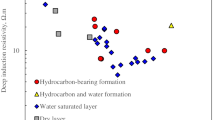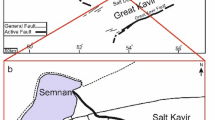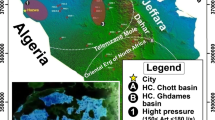Abstract
Understanding the depositional and development of hydrocarbon reservoirs is fundamental process to hydrocarbon exploration. Typically, water samples and remote sensing methods from existing or potential reservoirs can be used for interpretation of depositional environment. However, the lack of data in reservoirs represents a challenge for further exploration. The purpose of this study, the hydrocarbon potential of Hatay province was investigated by evaluating the geological, geochemical, hydrogeochemical and remote sensing methods. In this study, the methods of Liu et al. (Appl Geochem 97:226–237, 2018. https://doi.org/10.1016/j.apgeochem.2018.07.010) and Hashimov (J Geol Resour Eng 2015:42–48, 2015. https://doi.org/10.17265/2328-2193/2015.01.006) for radon gas and hydrocarbon relations; method of Hosseinpour (Arab J Geosci 13:511, 2020) for hydrocarbon induced alterations; for theory of conceptual microseepage from Tedesco (Surface geochemistry in petroleum exploration, Springer, Boston, 1995); classifications of Sulin (Waters of petroleum formations in the system of nature waters, Gostoptekhizdat, Moscow, 1946), Schoellers (1955), Chebotarev (Geochim Cosmochim Acta 8:22–48, 137–170, 198–212, 1955), Wei et al. (Chin J Geochem 15(4):374–382, 1996), Bojarski Bojarski (Angew Geol 16:123–125, 1970), Vel'kov (Pet Geol Dig Russ Lit Pet Geol 4(9B):539–541, 1960) and Schoeneich (Nafta (Pol) 27:154–157, 1971) for hydrogeochemical classifications; classification of Schoellers (1955) for index of base exchange (IBE) hydrocontours; classification of Sulin (1946) for Na/Cl hydrocontour; methods of Hashimov (2015) and Schumacher (2016) for macroseepage data were used and interpreted. As a result of the evaluation of radon data from soil gases, areas that could be potential reservoirs in the Amik basin were determined. Fossil waters representing stable conditions in which hydrocarbons can be trapped have been identified by hydrogeochemical methods. In addition, hydrocarbon induced alterations possible hydrocarbon microseepage areas were detected with remote sensing method and hydrocarbon field detection was made by adapting to conceptual microseepage theory model. In this study, where all these methods were evaluated together, it was seen that the Amik Basin and the west of Reyhanlı could be evaluated in terms of hydrocarbon deposits in the study area. This study can be applied for assessment of reservoir distribution and reduction of uncertainty during hydrocarbon field exploration and used to similar hydrocarbon reservoirs.
Article Highlights
The hydrocarbon potential of Hatay province was investigated by evaluating the geological, geochemical, hydrogeochemical and remote sensing methods in the study. Combined geochemical, hydrochemical and soil gas methods show a hydrocarbon reservoir under Amik Basin (Hatay), and also a giant microseepage zone was detected by remote sensing methods. In this study, where all these methods were evaluated together, it was seen that the Amik Basin and the west of Reyhanlı could be evaluated in terms of hydrocarbon deposits in the study area. This study can be applied for assessment of reservoir distribution and reduction of uncertainty during hydrocarbon field exploration and can be used to similar hydrocarbon reservoirs explorations.


Modified from Karatas (2016)

Modified from MTA (2002)






Similar content being viewed by others
References
Akçay Y, Kansu E, Yılmaz H (2013) İskenderun Körfezi Petrol Sistemi ve Basen Modellemesi, TPJD Bülteni, Cilt. 25, Sayı. 2, Yıl, 2013, pp 31–59
Bojarski L (1970) Die Anwendung der hydrochemischen Klassifikation bei Sucharbeiten auf Erdol. 2. AngewGeol 16:123–125
Brehme M, Scheytt T, Çelik M et al (2011) Hydrochemical characterisation of ground and surface water at Dörtyol/Hatay/Turkey. Environ Earth Sci 63:1395–1408. https://doi.org/10.1007/s12665-010-0810-1
Chebotarev II (1955) Metamorphism of natural waters in the crust of weathering, 1–3. Geochim Cosmochim Acta 8: 22–48, 137–170, 198–212
Coşkun B (1994) Oil possibilities of duplex structures in the Amik - Reyhanlı basin, SE Turkey. J Pet Geol 17(4):461–472
D’Alessandro W, Yüce G, Italiano F, Bellomo S, Gülbay AH, Yasin DU, Gagliano AL (2018) Large compositional differences in the gases released from the Kizildag ophiolitic body (Turkey): evidences of prevailingly abiogenic origin. Mar Pet Geol 89:174–184. https://doi.org/10.1016/j.marpetgeo.2016.12.017
Gülbay AH (2015) Gaz Ölçümleri ile örtülü kırık zonların belirlenmesi: Güzelburç Kırığı, Antakya, Eskişehir Osmangazi Üniversitesi, Yüksek Lisans Tezi, Fen bilimleri Enstitüsü, Jeoloji Mühendisliği Bölümü
Hashimov S (2015) Gas ratio analysis in Hovsan oil field. J Geol Resour Eng 2015:42–48. https://doi.org/10.17265/2328-2193/2015.01.006
Hosseinpour M (2020) Relationship between hydrocarbon micro-seepages and structures by detection of altered minerals using ASTER remote sensing data in the West of Coastal Fars, Zagros, Iran. Arab J Geosci 13:511. https://doi.org/10.1007/s12517-020-05568-4
Karatas A (2016) Sustainable water management in Hatay: hydrographic planning approach. In: Water resources management in the lower Asi-Orontes River Basin: issues and opportunities, Geneva: Graduate Institute of International and Development Studies; Istanbul, MEF University, 2016, pp 111–123
Liu P, Luo X, Wen M, Zhang J, Zheng C, Gao W, Ouyang F (2018) Geoelectrochemical anomaly prospecting for uranium deposits in southeastern China. Appl Geochem 97:226–237. https://doi.org/10.1016/j.apgeochem.2018.07.010
MTA (2002) Geological map of Turkey-Hatay, General Directorate of Mineral Research and Exploration 06520 Ankara, Turkey
Ozdemir A, Şahinoğlu A (2018) Prospective areas for petroleum exploration and oil & gas potential of the onshore Hatay. In: 18th international multidisciplinary scientific GeoConference (SGEM 2018), conference paper
Ozdemir A, Turgay SO, Şahinoğlu A (2018) High accuracy estimation with computer-aided hydrochemical methods of oil and gas deposits in wildcat sedimentary basins. J ApplGeolGeophys 6(4):62–104
Ozdemir A, Karataş A, Palabiyik Y, Sahinoglu A (2020a) Reservoir-targeted oil and gas exploration in the Karaburun Peninsula (Western Turkey). Int J Energy EngSci 5(2):115–145
Ozdemir A, Palabiyik Y, Karataş A, Sahinoglu A (2020b) Organic geochemical evidence of the working petroleum system in BeypazarıNeogene Basin and potential traps (Northwest Central Anatolia, Turkey). Turk J Geosci 1(2):35–52
Ozdemir A, Karataş A, Palabiyik Y, Yaşar E, Sahinoglu A (2020c) Oil and gas exploration in Seferihisar Uplift (Western Turkey) containing an operable-size gold deposit: geochemical evidence for the presence of a working petroleum system. GeomechGeophys Geo-Energy Geo-Resour 6:30. https://doi.org/10.1007/s40948-020-00152-2
Ozdemir A, Palabiyik Y, Karataş A, Sahinoglu A (2022) Mature petroleum hydrocarbons contamination in surface and subsurface waters of KızılırmakGraben (Central Anatolia, Turkey): geochemical evidence for a working petroleum system associated with a possible salt diapir. Turk J Eng 6(1):1–15
Saroglu F, Emre O, Kuscu I (1992) The East Anatolian fault zone of Turkey. Ann Tectonicae VI: 99–125
Schoeller H (1955) Geochemie des eaux souterraines. Rev Znst Fr Pet 10:181–213, 219–246, 507–552
Schoeneich K (1971) Indices of oil bearing deposits as based on the formation waters of Poland. Nafta (Pol) 27:154–157
Schumacher D (2017) Minimizing exploration risk: the impact of hydrocarbon detection survets for distinguishing charged from uncharged traps, AAPG, search and discovery article, 42073
Sulin VA (1946) Waters of petroleum formations in the system of nature waters. Gostoptekhizdat, Moscow (in Russian)
Tedesco SA (1995) Surface geochemistry in petroleum exploration. Springer, Boston
Tekeşin Ö (2011) Hatay (Antakya) – Samandağ Arasındaki Neotektonik Dönem Yapılarının Araştırılması, İTÜ Avrasya Yerbilimleri Enstitüsü, Yüksek Lisans Tezi, İstanbul
Turgay SO, Yaşar E (2018) HYDROPET Yazılımı ile Hatay Bo¨lgesinin Hidrokarbon Potansiyelinin Deg˘erlendirilmesi, 8. Jeokimya Sempozyumu, Bildiriler Kitabı, Antalya
Turgay O, Yaşar E (2020) Hydropet as an exploration tool. In: International European Conference on interdisciplinary scientific researches. Ankara/TURKEY
Vel’kov AM (1960) Hydrochemical indicators of gas-oil productivity. Pet Geol Dig Russ Lit Pet Geol 4(9B):539–541
Wei L, Limin L, Xiaohong C (1996) Geochemical characteristics of oilfield waters fromthe Turpan Depression, Xinjiang and their petroleum geological significance. Chin J Geochem 15(4):374–382
Yang S (2017) Fundamentals of petrophysics. Springer, Berlin
Yüce G (2001) Hatay (Erzin) Yeşilkent Ovası ve Burnaz Kaynağının Hidrojeolojik Özellikleri, Jeoloji Mühendisliği Dergisi 25(2)
Yüce G (2007) Yenişehir Ve Cüdeyde (Reyhanlı – Hatay) Karst Kaynaklarının Boşalım Hidrodinamiği ve Hidrojeokimyasal Özellikleri. Eskişehir Osmangazi Üniversitesi Mühendislikve Mimarlık Fakültesi Dergisi 20(2):159–188
Yuce G, Italiano F, D'Alessandro W, Yalcin TH, Yasin DU, Gulbay AH, Ozyurt NN, Rojay B, Karabacak V, Bellomo S, Brusca L, Yang T, Fu CC, Lai CW, Ozacar A, Walia V (2014) Origin and interactions of fluids circulating over the Amik Basin (Hatay, Turkey) and relationshipswith the hydrologic, geologic and tectonic settings. Chem Geol 388:23–39. https://doi.org/10.1016/j.chemgeo.2014.09.006
Yüce G, Fu CC, D'Alessandro W, Gulbay AH, Lai CW, Bellomo S, Yang TF, Italiano V, Walia F (2017) Geochemical characteristics of soil radon and carbon dioxide within the Dead Sea Fault and Karasu Fault in the Amik Basin (Hatay), Turkey. Chem Geol 469:129–146. https://doi.org/10.1016/j.chemgeo.2017.01.003
Author information
Authors and Affiliations
Corresponding author
Additional information
Publisher's Note
Springer Nature remains neutral with regard to jurisdictional claims in published maps and institutional affiliations.
Rights and permissions
About this article
Cite this article
Turgay, S.O., Yaşar, E. Evaluation of hydrocarbon occurrences of Hatay with integrated methods, SE Turkey. Geomech. Geophys. Geo-energ. Geo-resour. 7, 54 (2021). https://doi.org/10.1007/s40948-021-00239-4
Received:
Accepted:
Published:
DOI: https://doi.org/10.1007/s40948-021-00239-4




